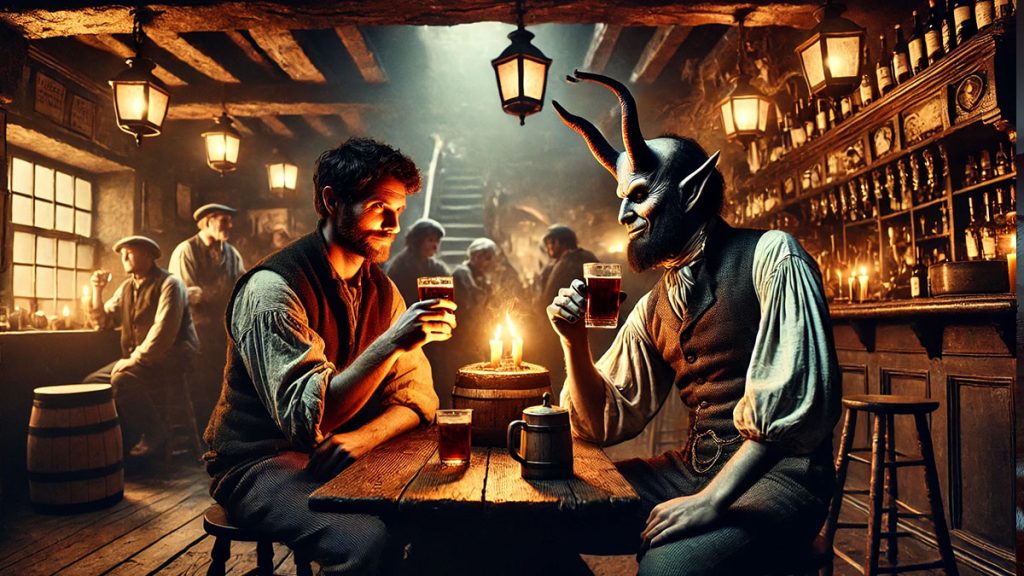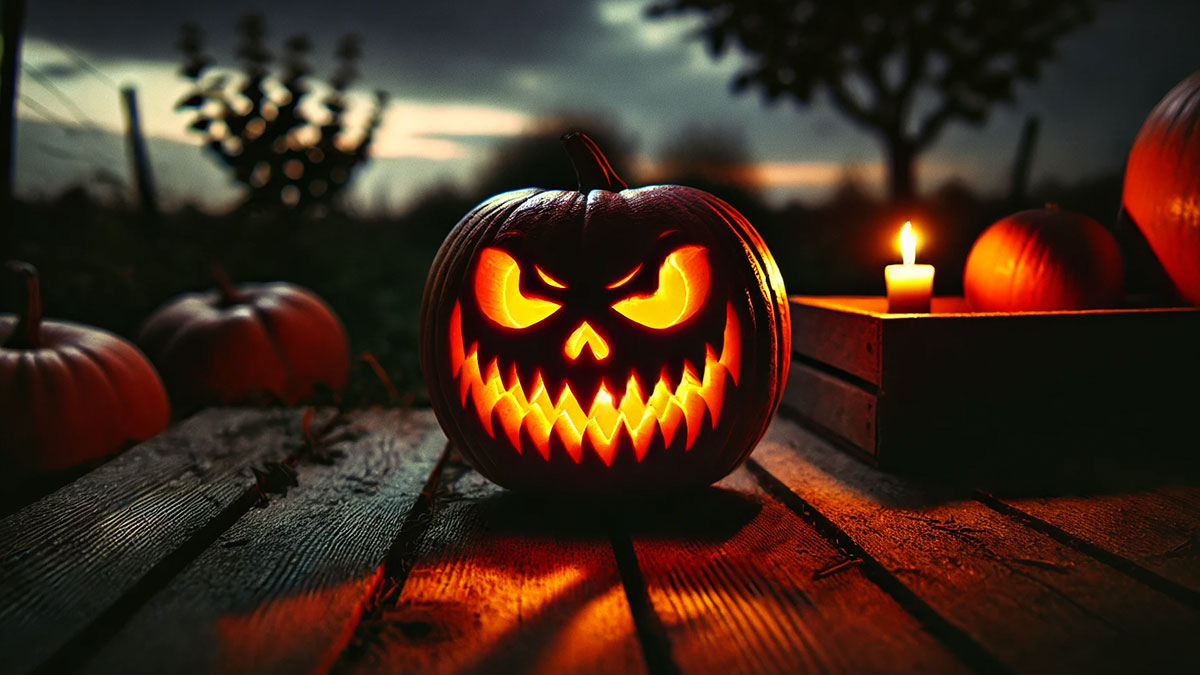Today, the term Jack o’ lantern or Jack of the lantern is used to describe the Halloween custom of carving out the innards of a pumpkin, usually to form a scary face, and placing a light inside to form a rudimentary lantern. However, the origins of this custom go back hundreds of years and most likely came about due to the appearance of ghostly lights over bogs and marshy land in rural Ireland.
Across Great Britain and Ireland and worldwide, people have noticed ghostly lights flickering and moving across marshy, boggy, or swampy land for centuries. The strange phenomenon has many names: Jack o’ lantern in Ireland, Will-o-the-wisp in Britain, or ignis fatuus in Latin, meaning “foolish fire.” In the USA and Canada, the ghostly lights are often called orbs or simply ghost lights.

There are many theories about what causes this ghostly apparition, ranging from mischievous fairies or spirits and lost souls to a chemical reaction within the boggy soil. These strange apparitions are usually considered to be malevolent because they lure weary travelers off the beaten track, causing injury or death. In some cases, the lights are seen as a harbinger of death, similar to a banshee, foretelling the death of a loved one.
The legend of Stingy Jack and his lantern and the Devil
In Ireland, a story emerged that explained the existence of this ghostly light. The legend of Stingy Jack first appeared in print in the 19th century, but the tale could date back to the 17th century or even earlier. There are many versions of the story, but they mostly follow the same idea. By all accounts, Stingy Jack was a total rascal who loved a drink but didn’t like paying for it. One day, he encountered the Devil, and the pair went for a beer at a tavern/pub.

When the time came for them to pay for their drinks, both Jack and the Devil claimed they had no money. Jack leaned toward the Devil in a conspiratorial fashion and asked if he could turn his form into a coin, and when the Devil said “yes,” they hatched a plan. The Devil would turn himself into a coin, and Jack would use it to pay the barman. But once the barman had put down the coin and turned his back, the Devil could revert to his old form and sneak off.
However, as soon as the Devil turned into a coin, Jack snapped him up and put him in his pocket beside a silver cross, meaning the dark lord could not escape. Jack made a bargain with the Devil; he agreed to release him so long as the Devil left him alone for a year and wouldn’t claim his soul.
The Devil agreed to those terms, but after a year, he returned. Again, Stingy Jack tricked him. Jack had the Devil climb a tree to pick him an apple, and once the Devil was up on a branch, he carved a crucifix into the trunk, trapping him up the tree. This time, the price for the Devil’s freedom was to leave Jack alone for ten years and not claim his soul.
Stingy Jack o’ lantern was doomed to wander the Earth forever
A few years later, Stingy Jack passed away and found himself at the Pearly Gates, where St Peter turned him away because of his bad deeds. Jack sought entry into hell, but the Devil refused to let him in, cursing him to roam the Earth for all eternity.
Jack requested a lump of coal to keep him warm and light his way. He put the coal into a lantern fashioned from a carved-out turnip, and since then, he has become Jack of the lantern, as his soul has shuffled the Earth holding his lantern. Travelers who spot Jack’s lantern at night may be fooled into thinking it is the light of home or may be tempted to follow the light, which could cause injury or worse.
During the Celtic festival of Samhain on November 1, the Irish would carve out vegetables, especially turnips, and put lights inside, which were thought to ward off Jack and other evil spirits. This custom was transported to the United States by Irish migrants, who found the pumpkin, which is far more common in the US, to be much easier to carve than a turnip.
As an aside, a less romantic origin for the name Jack o’ lantern may come from the 17th-century practice of referring to a man you didn’t know as “Jack,” which often led to night watchmen being called Jack-of-the-Lantern.
Will-o-the-wisp and Jack o’ lantern lights could be the souls of trapped spirits
Outside of Ireland, the phenomenon of mysterious lights is often referred to as the will-o-the-wisp. These ghostly apparitions have often been explained as the souls of individuals who are trapped on Earth, unable to get into heaven or hell, just like Stingy Jack. Plenty of tales across Britain tell of a character called Will who had a similar experience to Jack and was trapped on Earth.
However, the legend of Will or Jack does not explain why travelers have often seen multiple lights. One theory suggests that not only Jack but multiple souls have found themselves unable to enter either heaven or hell and that these lights are their trapped souls. A third theory argues that the lights are spirits the Devil has sent back to Earth with the sole purpose of leading people to danger. For example, a weary traveler may follow the lights only to fall down a hole or a ravine.
Some believe the lights are the fairy folk, and while they may be mischievous, they likely don’t want to cause actual bodily harm. According to folklorist Liana Paraschaki, Swedish legends state that the will-o’-the-wisp are unbaptized spirits who are trying to lure travelers to water in the hope they will be baptized.
Will-o-the-wisp lights have terrorized Scottish island for 200 hundred years
A will-o-the-wisp has been appearing on the Scottish island of South Uist since about 1812, and there are two explanations recounted about it. Firstly, the ghostly light is thought to be from the spirit of a blacksmith who could not enter either heaven or hell. The spirit was incredibly cold and begged for an ember, which he received, but is now condemned to roam the Earth, shivering with his single glowing ember.
The second legend explaining the South Uist ghostly light veers away from the Jack/Will narrative and tells of the ghost of a young girl from Benbecula. In life, the girl would spend her time collecting galium verum (Lady’s bedstraw), a plant used for making cloth or tweed. However, the girl withheld an unfair share of the plant instead of sharing it with her community. This sin condemned her spirit to roam the sandy beaches of South Uist for all eternity. This legend couldn’t be more transparent as a precautionary tale.
Does the will-o-the-wisp foretell the death of a loved one?
In some cultures, the will-o’-the-wisp is seen as a harbinger of death, similar to the Banshee, and the appearance of the strange light could indicate the death of a family member. This theory is prevalent in Wales, particularly in the West Glamorgan, Carmarthen, and Pembrokeshire regions.
One story from Carmarthen tells the experience of the friends and family of a sea captain known as Jack. In 1880, Jack was working on his ship on the other side of the world when a cousin from a neighboring farm asked, “Is Jack come home?” and when he was informed that Jack had not returned, the cousin said he had seen a light in Jack’s room. A short time later, another family member noticed a strange dim light in Jack’s room.
The following night, Jack’s mother went into the room to pull down a blind when she saw a dim light hovering over her son’s bed. She ran downstairs, shocked and terrified, and was convinced something bad had happened to Jack. A few weeks later, the family learned that Jack had passed away in Singapore from a fever and that his death had occurred around the same time the ghostly lights had appeared in his room.
Are Jack o’ lantern lights caused by escaping gas?
Major Louis Blesson (1790-1891) wrote extensively about his experiences observing Jack o’ lantern lights in central Europe. In the early 19th century, Blesson, calling the phenomenon will-o-the-wisp, wrote of seeing the phenomenon in marshy land in the Forest of Gorbitz near Dresden, Germany. During the day, he observed bubbles rising from the boggy area, but at night this appeared as blue flames.
Blesson observed mysterious lights across modern-day Poland, Czechia, and Germany for several years and concluded that they were caused by escaping gas. He wrote, “They are of a chemical nature, and become inflamed on coming in contact with the atmosphere, owing to the nature of their constitution.”
Modern-day scientists largely concur with the Major, suggesting the will-o-the-wisp is most likely caused by a reaction to the oxidation of methane, diphosphine, and phosphine, which comes from decaying organic material.
References
Ashliman, D. L. “Will-o’-the-Wisp, Jack-o’-Lantern,” at the University of Pittsburgh, accessed September 30, 2024.
Bachelor, Blane. “The twisted transatlantic tale of American jack-o’-lanterns,” in National Geographic, accessed October 12, 2024.
Blesson, L. “Observations on the Ignis Fatuus, or Will-with-the-Wisp, Falling Stars, and Thunder Storms,” in The Edinburgh New Philosophical Journal, Vol XIV, (1832), accessed September 30, 2024.
Carnegie Museum of Natural History. “The Jack-O-Lantern’s Origins,” accessed October 2, 2024.
History.com, “How Jack O’Lanterns Originated in Irish Myth,” accessed October 12, 2024.
Merriam-Webster.com, “Will-o’-the-wisp,” accessed September 30, 2024.
Nutt, David. “Folk-lore Vol. xiii,” (1902), accessed September 30, 2024.
Paraschaki, Liana. “Will-o’-the-wisp,” in FolkloreScotland.com, accessed October 2, 2024.
Petersen, Marie. “Will-o’-the-wisps; or Lights and sprites,” (1862), accessed September 30, 2024.
Trevelyan, Marie. “Folk-lore and Folk-stories of Wales,” Pub.: E. Stock, (1909), accessed September 30, 2024.
